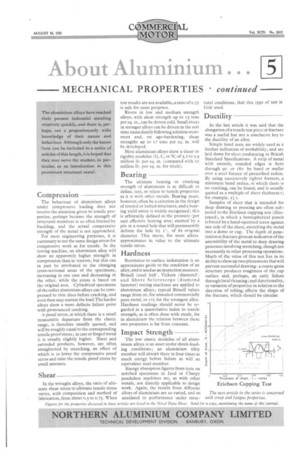About Aluminium
Page 84

If you've noticed an error in this article please click here to report it so we can fix it.
MECHANICAL PROPERTIES • continued Compression
The behaviour of aluminium alloys under compressive loading does not receive the attention given to tensile properties, perhaps because the strength of structural members is so often limited by buckling, and the actual compressive strength of the metal is not approached.
For most engineering purposes, it is customary to use the same design stress for compressive work as for tensile. In the testing machine, an aluminium alloy will show an apparently higher strength in compression than in tension, but this can in part be attributed to the changing cross-sectional areas of the specimens, increasing in one case and decreasing in the other, while the stress is based on the original area. Cylindrical specimens of the softer aluminium alloys can be compressed to thin discs before cracking, and even then may sustain the load_The harder alloys show a more definite failure point with pronounced cracking.
A proof stress, at which there is a small measurable departure from the elastic range, is therefore usually quoted, and will be roughly equal to the corresponding tensile proof stress; in cast or forged metal it is usually slightly higher_ Sheet and extruded products, however, are often straightened by stretching, an effect of which is to lower the compressive proof stress and raise the tensile proof stress by small amounts.
Shear
In the wrought alloys, the ratio of ultimate shear stress to ultimate tensile stress varies, with composition and method of fabrication, from about 0.5 to 0.75. When test results are not available, a ratio of 0.55 is safe for most purposes.
Rivets in low and medium strength alloys, with shear strength up to 13 tons per sq. in can be driven cold. Small rivets in stronger alloys can be driven in the soft state immediately following solution treatment and, on age-hardening, shear strengths up to 17 tons per sq. in. will be developed.
Most aluminium alloys show a shear or rigidity modulus (G, C, or N) of 3.7 to 3.9 million lb. per sq. in. (compared with 12 million lb. per sq. in. for steels).
Bearing
The ultimate bearing or crushing strength of aluminium is as difficult CO define, test, or relate to tensile properties as it is with other metals. Bearing must, however, often be a criterion in the design of riveted or bolted structures, and a bearing yield stress is widely recognized; this is arbitrarily defined as the pressure (per unit effective bearing area) exerted by a pin in a round hole that will permanently deform the hole by t, of its original diameter. This stress, for most alloys approximates in value to the ultimate tensile stress.
Hardness
Resistance to surface indentation is an approximate guide to the condition of an alloy, and is used as an inspection measure. Brinell (steel ball', Vickers (diamond), and Shore Scleroscope (diamond hammer) testing machines are applied to aluminium alloys ; typical Brinell values range from 20, for annealed commercially pure metal, to 175 for the strongest alloy. Hardness readings should never be regarded as a quantitative index to tensile strength, as is often done with steels, for in aluminium the relation between these two properties is far from constant.
Impact Strength
The low elastic modulus of all aluminium alloys is an asset under shock-loading conditions; an aluminium alloy member will absorb three to four times as much energy before failure as will an equivalent steel member.
Energy absorption figures from tests on notched specimens in lzod or Charpy pendulum machines are, as with other metals, not directly applicable to design work. Again, the results from different alloys of aluminium are so varied, and so unrelated to performance under struc
tural conditions, that this type of test is little used.
Ductility
In the last article it was said that the elongation of a tensile test piece at fracture was a useful but not a conclusive key to the ductility of an alloy.
Simple bend tests are widely used as a further indication of workability, and are laid down for sheet conforming to British Standard Specifications. A strip of metal with smooth, rounded edges is bent through 90' or 18o by hand or mallet over a steel former of prescribed radius. By using successively tighter formers, a minimum bend radius, at which there is no cracking, can be found, and is usually quoted as a multiple of sheet thickness t; for example, q. t.
Samples of sheet that is intended for deep drawing or pressing are often subjected to the Erichsen cupping test (illustrated), in which a hemispherical punch is forced by a hand-operated screw against one side of the sheet, stretching the metal into a dome or cup. The depth of penetration at fracture gives an indication of the amenability of the metal to deep drawing processes involving stretching, though not necessarily to other processing operations. Much of the value of this test lies in its ability to show up two phenomena that will prevent successful drawing: a coarse grain structure produces roughness of the cup surface and, perhaps, an early failure through local thinning; and directionality, or variation of properties in relation CO the direction of rolling, affects the shape of the fracture, which should be circular.




















































































